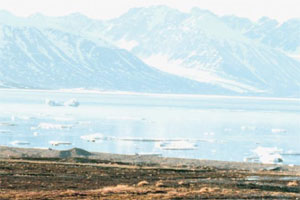Ordering the world’s enormous climatic variety is not an easy task. Throughout the years, scientists have taken several natural indicators into account, so there is no single classification for the climates that exist on our planet, but several. The most recurrent analyses tend to analyze two main elements: temperature and precipitation.
Due to this, generally, a kind of statistical chart is used that registers the most relevant climatic data. It receives the name of climogram and is a graph that represents the average temperatures and total precipitation that have been produced in a place throughout a year, organizing the data by months. The evolution of temperature and precipitation indicate a place’s climate. This way, it is possible to associate temperature and precipitation and find out the existence of humid and dry periods. In the humid months, the bars that indicate precipitation are above the temperature curve; on the other hand, in the dry months, the bars are below the temperature curve.
Considering our planet’s different latitudes and the imaginary lines Man has traced for their study, it is possible to perform an analysis of the world’s different climates by grouping them into some of the three great climatic zones: low latitude ones (from the equator to the tropics), mid-latitude (from the tropics to the polar circles) and high latitude (spanning from the polar circles to the poles). It is also necessary to point out that the location of the climates described next are not exclusive, there can be more than one variety at the same latitude. This is explained by the multiple factors that affect the conformation of this distribution.
Low latitude climates
– Rainy equatorial climate: it is located in the areas that go from the equator to approximately 10º latitude. Warm, humid masses of air predominate in it, which condition the presence of intense precipitation during a great part of the year (indicators show that they surpass 2,500 millimeters a year). It registers a considerable thermal uniformity, with an average temperature of 27ºC. This sector’s predominant humidity benefits the growth of an exuberant vegetation, like the one in the jungle.
– Monsoon and Westerly littoral winds climate: it takes place between 5º and 25º latitude, presenting very marked seasons, like a rainy one in summer (when the wind blows from the ocean to the interior) and a drier one in winter (moment in which wind performs the return trip). It has a scarce thermal oscillation, and in the areas where precipitation is more intense, it enables the growth of thick forests.
– Dry and humid tropical climate: located between 5º and 20º latitude, it is characterized for having a rainy season and another one with less precipitation. The latter is felt more intensely and lasts longer as one advances towards the tropics. Its average temperature is 20ºC.
– Dry tropical climate: characteristic of some desert areas, it presents stable, dry masses of air which grant great dryness. The temperatures are quite extreme if we analyze the differences between day and night. When the sun is at it’s highest point, the heat is the strongest, while when it descends, it gives way to an intense cold. Precipitations are pretty scarce and, generally, do not surpass 200 millimeters a year.
Mid-latitude climates
They spread throughout the Earth’s temperate zones, between the tropics and polar circles.These climates are characterized by the existence of four seasons, with noticeable temperature and precipitation differences among them.
– Dry subtropical climate: it is the continuation of dry tropical climate, but with a greater amount of precipitation and thermal amplitude. A few of the subtypes of this climatic variety are semi-desert, desert and steppe.
– Humid subtropical climate: it is found between 20 and 35º latitude, presenting a very warm, humid summer season with intense precipitation due to the influence of tropical marine masses of air. There are also considerable rains during winter; however, these are produced by the tropical storms of the mid-latitudes.
– Mediterranean climate: it is characterized for having short winters of mild temperatures and long, hot summers. Precipitation is not too abundant, never surpassing 800 millimeters, and they are concentrated in the spring and fall.
– West coast marine climate: it is limited to the western coasts of the continents, between 35º and 60º latitude. It is characterized by its great humidity and for having precipitations during all the months of the year. The occurrence of cyclonic storms are also frequent.
– Humid continental climate: it presents long, very cold, dry winters, with temperatures that can even reach below zero and short, very hot summers. Precipitation is abundant, normally above 600 millimeters, and are concentrated in the summer months. It has considerable thermal variations, which are not only related to the change of seasons, but are also produced throughout the day.
High altitude climates
– Boreal forest climate: generally, it develops between 50º and 70º north latitude (in the south it only shows up in a few islands). The winters are long and rigorous, while the summers are short and cold. It is a fairly humid climate, whose thermal oscillation is the highest in the world. Just as an example, we can cite the area of Siberia, which reaches 60ºC.
– Tundra climate: it develops between 60º and 75º latitude, taking up the coastal strips of the Arctic and the Antarctic continent. It is characterized by the enormous presence of cyclonic storms and for the development of very long winters, as well as precipitation exclusively in the form of snow.
– Icecap climate: it has the lowest temperatures on Earth. There is no summer, no temperature surpasses 10ºC and the few precipitations there are in snow form.
– High mountain climate: although it can present itself at any latitude because it is determined by altitude, this climate has well defined characteristics, like cold temperatures in winter and mild ones in summer, as well as abundant rains, frequently in the form of snow.








